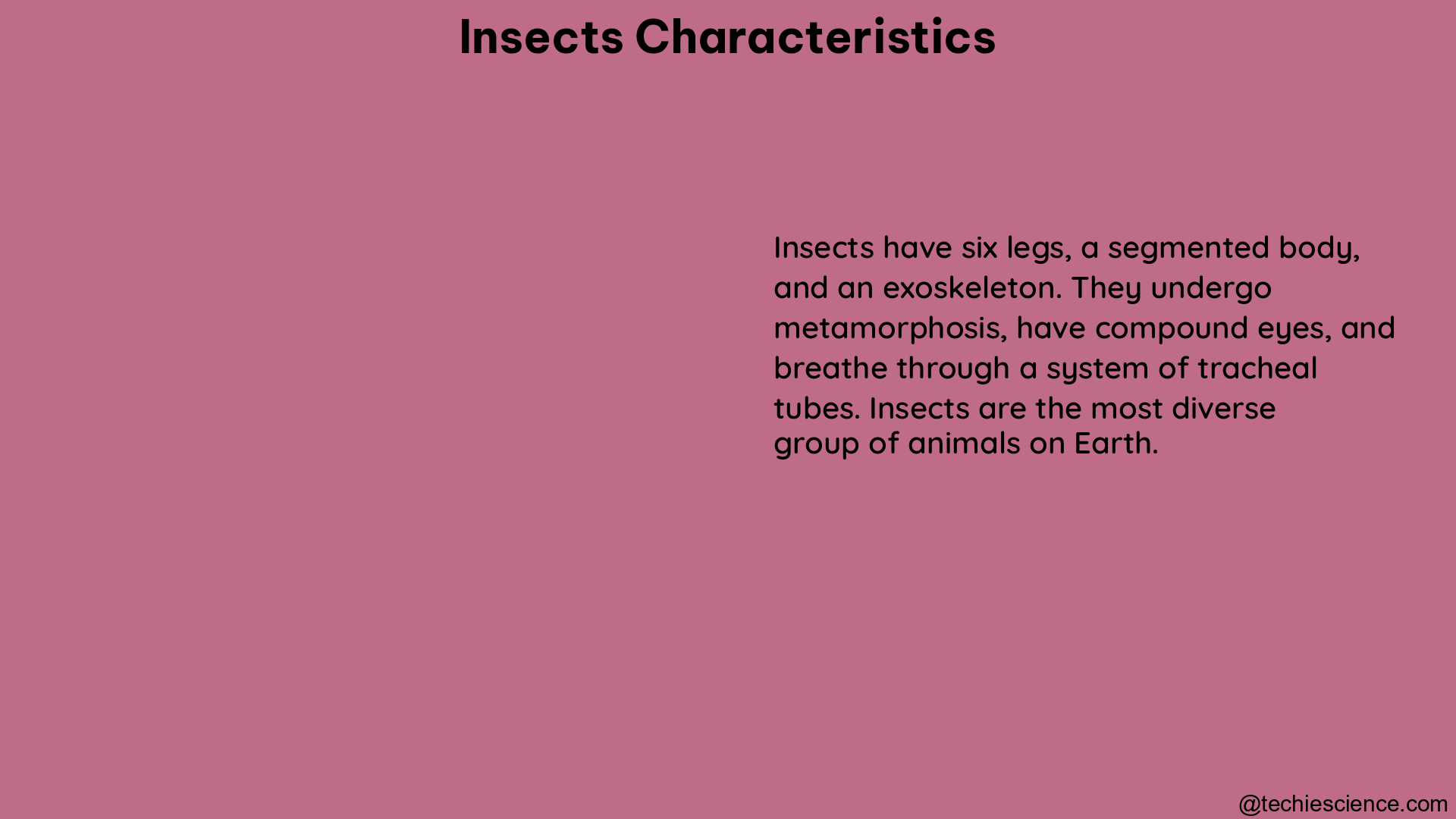Insects are a remarkably diverse group of organisms, boasting a wide range of unique characteristics that set them apart from other arthropods. From their intricate exoskeletons to their complex life cycles, insects display an astounding array of adaptations that have allowed them to thrive in virtually every corner of the planet. This comprehensive guide delves deep into the biological specifications and minute details that define the remarkable world of insects.
Exoskeleton: The Insect’s Protective Armor
One of the most distinctive features of insects is their exoskeleton, a hard, protective covering made of a tough material called chitin. This exoskeleton serves as a rigid support structure, providing protection for the insect’s internal organs and preventing dehydration. The exoskeleton is divided into several segments, including the head, thorax, and abdomen, which allow the insect to move and flex its body with remarkable agility.
The exoskeleton is composed of three main layers:
- Epicuticle: The outermost layer, which is waterproof and resistant to abrasion.
- Exocuticle: The middle layer, which is the thickest and provides the majority of the exoskeleton’s strength and rigidity.
- Endocuticle: The innermost layer, which is more flexible and allows for movement.
The composition and structure of the exoskeleton can vary significantly among different insect species, with some exhibiting specialized features such as spines, hairs, or even armor-like plates. For example, the exoskeleton of a beetle may be significantly more robust and durable than that of a delicate butterfly.
Legs and Locomotion: The Insect’s Versatile Appendages

Insects are characterized by the presence of three pairs of legs, which are attached to the thorax, the middle section of the body. These legs are used for a variety of locomotor functions, including walking, running, jumping, and even swimming in some aquatic species.
The structure of an insect’s leg is highly specialized, consisting of several distinct segments:
- Coxa: The segment that attaches the leg to the body.
- Trochanter: A small segment that connects the coxa to the femur.
- Femur: The largest and strongest segment, which provides the majority of the leg’s power.
- Tibia: The segment that connects the femur to the tarsus.
- Tarsus: The foot-like segment, which may be further divided into smaller subsegments called tarsomeres.
The arrangement and specialization of these leg segments can vary greatly among different insect species, allowing them to adapt to a wide range of environments and locomotor challenges. For example, the long, powerful legs of a grasshopper are well-suited for jumping, while the paddle-like legs of a water strider allow it to effortlessly glide across the surface of ponds and streams.
Wings and Flight: The Insect’s Aerial Mastery
In addition to their distinctive legs, most insects are also characterized by the presence of two pairs of wings, which are attached to the thorax. These wings are used for powered flight, a capability that sets insects apart from many other arthropods.
The structure of an insect’s wing is highly complex, consisting of a network of veins that provide support and allow for the precise control of wing movements. The wings are typically composed of a thin, membranous material called chitin, which is the same material that makes up the exoskeleton.
The size, shape, and number of wings can vary significantly among different insect species, reflecting their diverse adaptations and flight capabilities. For example, the delicate, lace-like wings of a dragonfly allow for rapid, agile flight, while the broad, powerful wings of a moth or butterfly are better suited for sustained, long-distance flight.
In addition to their primary role in flight, insect wings can also serve other functions, such as:
- Thermoregulation: Some insects use their wings to regulate their body temperature, either by basking in the sun or by shading themselves from the heat.
- Courtship and Mating: Many insects use their wings to produce distinctive sounds or visual displays during courtship rituals.
- Defensive Displays: Some insects can use their wings to startle or intimidate predators, such as the sudden opening of the brightly colored wings of a butterfly.
Life Cycle and Metamorphosis: The Insect’s Remarkable Transformation
Insects are characterized by a complex life cycle that involves several distinct stages, including egg, larva, pupa, and adult. This process, known as complete metamorphosis, allows insects to adapt to different environments and food sources at different stages of their lives.
The life cycle of an insect typically begins with the laying of eggs, which can vary greatly in size, shape, and number depending on the species. The eggs then hatch into larvae, which are often quite different in appearance and behavior from the adult form. Larvae typically focus on feeding and growing, undergoing a series of molts (ecdysis) to accommodate their increasing size.
After a period of larval growth, the insect enters the pupal stage, during which it undergoes a remarkable transformation. During this stage, the insect’s body undergoes a complete reorganization, with the larval structures breaking down and the adult structures forming. This process is known as metamorphosis, and it results in the emergence of the adult insect, which is often vastly different in appearance and function from the larval form.
The duration of each stage in the insect life cycle can vary significantly, ranging from a few days to several years, depending on the species and environmental conditions. Some insects, such as mayflies, have a very short adult lifespan, while others, like certain species of beetles, can live for several years.
Sensory Perception and Nervous System: The Insect’s Sophisticated Senses
Insects possess a highly developed nervous system that allows them to sense and respond to their environment with remarkable precision. This nervous system is centered around a brain, which is located in the head, and a series of ganglia (nerve clusters) that are distributed throughout the body.
Insects have a variety of specialized sensory organs that allow them to perceive their surroundings, including:
- Eyes: Insects can have simple eyes (ocelli) or compound eyes, which are made up of hundreds or thousands of individual visual units called ommatidia. These eyes allow insects to detect movement, color, and even polarized light.
- Antennae: Insects use their antennae to detect a wide range of stimuli, including touch, smell, and even sound. The structure and function of antennae can vary greatly among different insect species.
- Taste and Smell Receptors: Insects have specialized receptors on their mouthparts, feet, and other body parts that allow them to detect and respond to a variety of chemical cues, including those associated with food, mates, and predators.
- Mechanoreceptors: These receptors, which are located throughout the insect’s body, allow it to detect and respond to physical stimuli, such as touch, vibration, and changes in air pressure.
The insect’s nervous system and sensory organs work together to allow it to navigate its environment, find food and mates, and avoid predators. This sophisticated sensory perception is a key factor in the success and diversity of insects as a group.
Size and Diversity: The Insect’s Remarkable Range
Insects display an astounding range of sizes, from the tiny parasitic wasp Dicopomorpha echmepterygis, which measures just 0.139 millimeters in length, to the massive Hercules beetle, which can reach up to 17 centimeters in length. This incredible size diversity is a testament to the adaptability and success of insects as a group.
The largest insects are typically found in tropical environments, where they have access to abundant food and warm temperatures. These include the aforementioned Hercules beetle, as well as the giant weta of New Zealand and the titan beetle of the Amazon rainforest.
In contrast, the smallest insects are often found in more temperate or even colder climates, where their small size and low metabolic rate allow them to thrive in resource-limited environments. These tiny insects, such as the parasitic wasp mentioned earlier, are often so small that they can only be observed under a microscope.
Despite their remarkable size range, insects as a whole are the most diverse group of organisms on the planet, with over 1 million described species and countless more yet to be discovered. This diversity is a result of the insects’ ability to adapt to a wide range of ecological niches, from the depths of the ocean to the highest mountain peaks.
Ecological Importance and Threats
Insects play a vital role in the functioning of ecosystems around the world, serving as pollinators, decomposers, and even natural pest control agents. Many plants, including crops, rely on insects for pollination, while insects also play a crucial role in the decomposition of organic matter, recycling nutrients back into the soil.
However, insect populations are facing a number of threats, including habitat loss, pollution, and climate change. These threats are causing many insect species to decline, and in some cases, they are even driving species to extinction.
To better understand and protect insects, it is important to collect data on their populations and distributions. This can be done through a variety of methods, including trapping, counting, and monitoring. By collecting data on insects, we can better understand their needs and develop strategies to conserve them.
Conclusion
Insects are a truly remarkable group of organisms, displaying a wide range of unique characteristics that have allowed them to thrive in virtually every corner of the planet. From their intricate exoskeletons to their complex life cycles and sophisticated sensory perception, insects are a testament to the incredible diversity and adaptability of life on Earth.
As we continue to explore and study the world of insects, we can gain a deeper understanding of the complex and interconnected systems that sustain our planet. By protecting and conserving insect populations, we can ensure that these vital components of our ecosystems continue to thrive for generations to come.
References
- https://opendata.stackexchange.com/questions/11709/quantitative-data-on-number-of-insects-per-area-over-time
- https://www.frontiersin.org/journals/ecology-and-evolution/articles/10.3389/fevo.2020.579193/full
- https://www.researchgate.net/post/Hello-i-am-planning-to-measure-some-morphological-features-in-insects-What-is-a-good-method-of-taking-fotos-and-analysing-them
- https://eorganic.org/node/2721
- https://www.ncbi.nlm.nih.gov/pmc/articles/PMC8540812/

Hi….I am Anushree Verma, I have completed my Master’s in Biotechnology. I am a very confident, dedicated and enthusiastic author from the biotechnology field. I have a good understanding of life sciences and great command over communication skills. I thrive to learn new things every day. I would like to thank this esteemed organization for giving me such a great opportunity.
Let’s connect through LinkedIn- https://www.linkedin.com/in/anushree-verma-066ba7153